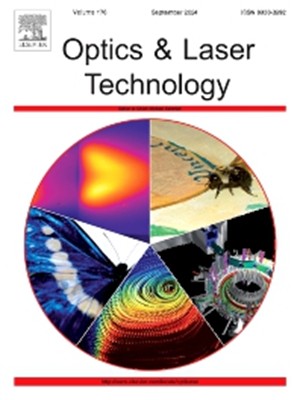用于 0.9 μm 激光的掺钕全固态反谐振硅酸盐光纤的设计、制造和热退火
IF 4.6
2区 物理与天体物理
Q1 OPTICS
引用次数: 0
摘要
我们报告了用于 0.9 μm 激光的掺钕硅酸盐玻璃全固态抗谐振光纤(Nd-AS-ARF)的设计、制造和特性分析。通过棒中管技术和高温拉伸技术,成功制造出了掺钕硅酸盐玻璃全固态抗共振光纤(Nd-AS-ARF),1200 nm波长处的本底损耗为0.3 dB/m。电子探针显微分析(EPMA)测试结果表明,钡元素在纤维拉伸过程中发生了显著扩散。额外的热退火可进一步加强元素扩散,从而使谐振波段向更长波长主动调节。在 30 cm 长的 Nd-AS-ARF 中,1.06 μm 波长的损耗比 0.92 μm 波长的损耗高出 10.5 dB,这有利于 Nd 三级激光器。据我们所知,这是首次制造出掺稀土的 AS-ARF。本文章由计算机程序翻译,如有差异,请以英文原文为准。
Design, fabrication and thermal annealing of Nd-doped all-solid anti-resonant silicate fibers for 0.9 μm laser
We report the design, fabrication and characterization of a Nd-doped silicate-glass-based all-solid anti-resonant fiber (Nd-AS-ARF) for 0.9 μm laser. Through the rod-in-tube technique combined with high-temperature drawing, the Nd-AS-ARF was successfully fabricated with a background loss of 0.3 dB/m at 1200 nm. The results of electron probe microanalysis (EPMA) test indicate a significantly diffusion of the Ba element accompanying the fiber drawing process. Additional thermal annealing could further enhance element diffusion, enabling the active regulation of the resonant band towards longer wavelengths. In the 30 cm-long Nd-AS-ARF, the loss at 1.06 μm is 10.5 dB higher than at 0.92 μm, favoring the Nd three-level laser. To the best of our knowledge, this is the first time that a rare-earth doped AS-ARF is fabricated.
求助全文
通过发布文献求助,成功后即可免费获取论文全文。
去求助
来源期刊
CiteScore
8.50
自引率
10.00%
发文量
1060
审稿时长
3.4 months
期刊介绍:
Optics & Laser Technology aims to provide a vehicle for the publication of a broad range of high quality research and review papers in those fields of scientific and engineering research appertaining to the development and application of the technology of optics and lasers. Papers describing original work in these areas are submitted to rigorous refereeing prior to acceptance for publication.
The scope of Optics & Laser Technology encompasses, but is not restricted to, the following areas:
•development in all types of lasers
•developments in optoelectronic devices and photonics
•developments in new photonics and optical concepts
•developments in conventional optics, optical instruments and components
•techniques of optical metrology, including interferometry and optical fibre sensors
•LIDAR and other non-contact optical measurement techniques, including optical methods in heat and fluid flow
•applications of lasers to materials processing, optical NDT display (including holography) and optical communication
•research and development in the field of laser safety including studies of hazards resulting from the applications of lasers (laser safety, hazards of laser fume)
•developments in optical computing and optical information processing
•developments in new optical materials
•developments in new optical characterization methods and techniques
•developments in quantum optics
•developments in light assisted micro and nanofabrication methods and techniques
•developments in nanophotonics and biophotonics
•developments in imaging processing and systems

 求助内容:
求助内容: 应助结果提醒方式:
应助结果提醒方式:


